What Do Travel Percentages Mean in a Job Description?
Written by Nathan Brunner .
Last updated on December 12, 2023.
“Travel percentages” refer to the amount of time that an employee is required to travel as part of their job responsibilities. Travel percentages include traveling to other cities, states, or countries to meet with clients and attend conferences.
For example, if a job description requires “50% travel,” the employee will be required spend roughly half of their time traveling and the other half working from their home office or the company’s headquarters.
Some jobs may require no travel at all, while others may involve extensive travel on a regular basis. Before accepting a job that involves travel, it’s important to carefully consider whether you’re willing and able to meet the job’s travel requirements.
Tip : Find Jobs on Salarship .

The Implications of Travel Percentages on Work-Life Balance
Different travel percentages can have significant implications for work-life balance.
For instance, if a job requires very little or no travel, an employee may be able to maintain a more consistent schedule and have more time for personal activities or family commitments.
On the other hand, frequent or extended travel can lead to fatigue, stress, and a lack of personal time, which can negatively affect an employee’s mental health and well-being .
Here is a quick table to help you understand how the different travel percentages will impact your life once you start your job:
- 10% travel — It means one or two months’ worth of business trips each year. In my experience, it is relatively easy to endure as it means a few travel days (or sometimes weeks) here and there.
- 25% travel — You will spend at least a quarter of your working hours away from your usual place of work. It amounts to 3 months per year, one week per month, or two days per week.
- 50% travel — It means constant overnight or international business trips for at least two weeks per month or six months a year. 50% of travel is usually mentioned in international business job descriptions.
- 75% travel — You will essentially live out of your suitcase and move from hotel to hotel for nine months per year, or three weeks each month. Most jobs that require you to travel three-fourths of the time are pretty stressful (e.g., high-paying jobs or jobs in the transportation industry ). You may rake in a hefty salary, but the tradeoff is little time for yourself, your family, and your non-work-related hobbies and goals.
On the bright side, companies usually shoulder most (if not all) of your travel expenses, including food expenses, hotel expenses, and transportation expenses.
How To Get a Job That Requires You To Travel
If you’re deadset on getting a job that includes a travel percentage in the description, here are a few tips to keep in mind — whether you’re writing your cover letter or answering an interview question on whether you’re willing to travel or not.
- Highlight any previous travel experience you have. You want to reassure your potential employer that you’re not likely to, say, suffer from jet lag, or commit novice mistakes like forgetting to apply for a visa in countries that require them.
- Be honest about the amount of time you’re willing to spend traveling. The more honest you are about what you want at the job application or interview stage, the more likely you’ll end up with a job that’s a good fit for you.
Tip : 1,068,520 Jobs Are Available on Salarship .
Final Thoughts
Evaluating the time you’ll be traveling in a job description can help you decide whether a position is right for you.
On the one hand, traveling often translates to more opportunities for promotion and career growth. On the other hand, traveling can be stressful and take a toll on your physical, mental, and psychological health.
Ultimately, it all boils down to your personal priorities and values.
Similar Articles
- The Meaning of “Clerical Speed And Accuracy” in a Job Description
- What Does “Internal Candidate” Mean When Applying for a Job
Salarship is a job board that focuses on low-competition jobs.
Our office is at Chemin du Valon 20, Sierre, Valais, Switzerland.
For Job Seekers
For Employers
Quick Links
Define 25% Travel
Would you say that 25% travel for a job is once every 3 months, on average?
No, I would say it means one week travelling out of four. That’s far more than once every three months.
Unless you’re away for three or four weeks at a time, once every three months.
Sorry, what job was this?
Or, you’re expected to be on the road 1 1/2 days every week.
This sounds like something in a job description – be sure you get it cleared up before you accept an offer.
It means you’ll be on the road for 25% of your work hours. That could be one full week a month, or a little over a day a week. My guess is that it’d be the former, or something along those lines, possily two short trips a month.
25% travel could be lots of things:
(1) A day at the boss’s/sponsor’s/customer’s facility each week, plus a half day of flying (e.g. a 12-hour Thursday every week, spent flying to and from Dubuque and then working a full day… which invariably means missing flights, crashing in hotels, missing birthdays, etc.)
(2) A week off site every month – could be somewhere cool or somewhere crappy, could be the same place every month or a new site every month – to do some secondary job that’s part of your description.
(3) A month at the end of each season where you’re set up in an apartment in another state/country and have to observe a major event: setting up a new store, launching a new product, testing the latest engine at the secret test track in Nevada.
It’s important to ask not only “how much is 25%” but also “where do most employees travel” and very importantly, “where would I be likely to travel?” You don’t want to find out once you get there that 25% means a month in Huntsville Alabama every three months, missing weekends at home with your family. Or with no family, your apartment or home sits empty and the bills pile up and maybe someone breaks in or a pipe bursts in December. And forget about having pets.
One job I quit it meant about one week a month. Except it was international travel, and required that I travel on weekends, and in steerage (tourist class) at that. So it actually meant I lost half of my weekends, and spent about a week a month at reduced functionality due to jet lag. It also meant working 10-12 hr days when abroad to try to accomplish 2 weeks worth of work during the week I was there, so no time to do touristy stuff.
So be sure to find out the particulars before accepting a a job. (not possible in my case, as this situation developed during the course of my employment.)
In some States, you’d be entitled to pay during that travel time, assuming you weren’t exempt, and YMMV, etc.
25% is whatever your employer defines it as
Some jobs consider airport time as leisure time, while you wait for your next plane. After all you could be doing something else?
Not the same but I had one employer that said they’d get me 40 hours a weeks. It consisted of 10 hour days, 12 hours days, split shifts and going home whenever I hit 40 hours (no overtime was the rule)
In my case travel time is based on nights spent away from home. If I left on Monday morning at 4:00 am, and returned on Tuesday at 11:40 pm, that was one day. Even if you left Monday at dawn and returned Friday at midnight that was only four days.
Vacations, holidays, and sick days did not count as work time, so if you had 10 holidays and 15 vacation days in a calendar year of 260 days to reach 25% you would have to spend 59 nights away from home. Last year I had 63.8% travel time.
I’ve always seen it as defined as nights away. A normal working year is about 230 to 240 days, so 25% travel would literally mean 55-60 nights away from home (and those estimates are usually low.)
My personal record is 55.3% travel, which frankly was about as much as I could possibly take, and the main reason I got another job.
25% travel is the maximum amount an interviewer will tell a job interviewee because he knows if he say 75% no one will accept the job. I think this must be standard practice in many industries.
If he really meant 25% he would have said “infrequent”. On the other hand, “occasional travel” means that you might as well not even own a house.
Slight digression here. I’ve taken jobs that advertised 100% travel and lived out of a suitcase (or two) for a few years. Some of us are more adventurous, even if we have to sit in cattle class. It helps to be minimally attached to things.
Since I’m here I may as well contribute my ¥2. As a road warrior, I always ask Jurph ’s questions during the interview. Sometimes the travel isn’t very far, a few hours by auto. Sometimes it’s half a day’s plane ride across a major ocean. Only the person interviewing you can answer that. Only you can determine if it’s a company-paid mini-vacation or weekly descent into the bowels of travel hell, Detroit Metro Airport to be exact. Just joking, Motor City Dopers!
For me, even more important than the quantity and configuration of the travel is Kevbo ’s question: whether time in transit is included as work hours. That is a dealbreaker for me. The job could have the most interesting duties, an office overlooking eyepopping beauty, and complementary blow jobs in lieu of coffee breaks, but I’d generally refuse if transit time is not part of work hours. If you’re distant from a convenient airport, may as well ask if driving time there is part of transit time, too. In many cities it could extend your travel drudgery an hour or more.
PS: No way would I want do one day a week if it involved air travel. Too much hassle for too few results. I hate flying.
Yeah, I agree with the posters…it is ambigous and all posts are correct. After I posted the question, i was thinking about what (in theory) 50% travel would mean. Once every 6 months (probably not) vs. every other week on the road.
Very open to interpretation!
Interview Questions
Comprehensive Interview Guide: 60+ Professions Explored in Detail
How to Answer “Are You Willing to Travel?” (Interview Question)
By Biron Clark
Published: December 5, 2023
If a job involves any travel, you’re likely to hear interview questions like, “Are you willing to travel?” “How much are you willing to travel?” etc.
So in this article, I’m going to walk you through how to answer all of these interview questions. And we’ll look at how to understand the meaning of “travel percentage,” so you’ll know what the job is really going to require before you say “yes” or “no.”
And finally, I’m going to share multiple word-for-word example answers to help you get confident and comfortable with this type of question. So make sure you read until the end.
Let’s get started…
Answers to “How Much Are You Willing to Travel?”
If they ask an open-ended interview question like this about your willingness to travel, you should state your answer as a percentage.
For example, you could say:
“I’m willing to travel up to 30% of the time. That’s what I did in my last job, and I know I’m comfortable with that amount.”
They may ask you directly for a percentage, with a question like, “what percentage are you willing to travel?” and you’d answer that in the same way. What does travel percentage mean, though? If you’re not sure, it’s essential to understand. So let’s discuss the meaning of “travel percentage.”
Travel percentage meaning: What is travel percentage?
So what does 70 percent travel mean? It means that the employer expects you to be traveling or in cities other than your home city for 70 percent of your working days. So you would expect to spend seven days traveling or away from home for every three days in your home town/office.
This is a very high amount of travel. In my experience working as a recruiter , most travel jobs are 50% or below, because this is less stressful and more sustainable for the worker. So, this is something to keep in mind when deciding how much you’re willing to travel, and whether you’ll take or decline the job offer .
How to Answer, “Are You Willing to Travel X Amount?” – Examples
The hiring manager may also come out and tell you how much travel is involved, and then ask an interview question to determine if this is an acceptable travel amount. In this case, if it’s acceptable to you, then you can indicate that you are on-board with what they’re proposing. For example, you could say:
“That amount of travel will work for me. In my last company, I traveled that same amount, and it worked out fine.”
(It’s always good to show you’ve done something successfully in the past. This is the best way to improve to a new employer that you’ll be successful with them, too!)
No worries if you haven’t traveled for a job before, though…
Here’s an example of how you could still answer this question:
“That amount of travel sounds acceptable to me. I have no problem doing that for this role.”
Here’s another example:
“That sounds acceptable to me. I’d love to hear more about the role, and if it’s a good fit, then I am able to travel.”
Make Sure You Know What You’re Agreeing To
Another thing to keep in mind is the actual travel schedule. Two jobs could both have the same travel percentage – let’s say 50%. But one could have you spending two weeks away and then two weeks at home, while the other could have you traveling for 2-3 days at a time, returning, and doing it all again a few days later.
Depending on your family, children, etc., you may be able to handle one of these travel requirements but not the other. So the travel duration and schedule are two factors you should clarify before answering. You can say, “I would like to understand the company travel schedule a bit better. Can you give me an example of how long each trip would be, or what a typical month looks like?” This will help you get a clear picture of what your work schedule would look like before you answer the interview question. So don’t be afraid to ask questions of your own. You can’t answer interview questions like, “Are you willing to travel for this job?” without knowing what the company expects! For example, if they ask, “Can you travel if the job requires it?” you’d want to respond by saying, “How much travel is expected in the role?” You can’t give a good answer without knowing what they’re proposing or asking, so clarify that first. Once you know what the company expects, then it’s time to directly answer their question and indicate whether you can travel the amount they require.
You Can Also Try to Negotiate Your Travel Percentage/Willingness to Travel
If you’re interested in the job but can’t travel quite as much as they’re proposing, you can say:
“I don’t think I can travel quite that amount. The job and work sound interesting, and I’d love to consider the position if the travel requirements can be reduced to 30%”.
This may work, or it may not (depending on the role and company’s flexibility), but it’s worth asking! This way, you’ll find out the best they can do! You never know if they’re asking, “How much are you willing to travel?” because it’s a hard requirement, or if they’re just wondering how much you’re willing to do So give an honest answer and don’t be afraid to make a counter-proposal.
A lot of job seekers are afraid to set limits or “push back” in a job interview, but this can actually make you more attractive to the company. It shows confidence! However, you also don’t want to rule yourself out in an interview. So if you’re not quite sure, but think it’s possible to travel the amount that the company would like, just say “yes” for now. You’re not accepting the job or signing a contract. You’re just indicating whether this might be possible for you. And your goal in any interview is to get invited to the next step in the process… or get a job offer. So if you think it’s even remotely possible to travel the amount they want, then yes “Yes” and keep interviewing!
You can always go home and talk to friends and family and make a better decision about whether this is right for you! You do NOT need to decide this in the interview!
How to Answer, “Are You Willing to Travel or Relocate?” – Examples
This is a slightly different question. But just like with the questions and sample answers above, you should give an honest, upfront answer. There’s no sense in wasting their time if you absolutely cannot relocate. But if it’s even slightly possible, say “Yes” when an employer asks if you’re willing to relocate. Don’t rule yourself out.
Remember: Your goal in the interview is to impress them and get invited back to the next round – so keep going with the job interview, and ask questions to learn more as you go! You’re NOT wasting the recruiter’s or hiring manager’s time by exploring the opportunity, as long as there’s a tiny chance you’d be willing to travel or relocate for the job. They want the opportunity to sell you on their position! I can’t stress this enough: You’re not wasting their time. I hear a lot of job seekers bring up concerns about this, so I just wanted to set the record straight!
You should now know what travel percentage is, and how to answer any time an employer asks about what percentage you’re willing to travel.
Remember – you’re not signing a contract or agreeing to anything in writing; you’re merely indicating whether this could potentially work (for the right opportunity). So stay calm, use the sample answers above, and be direct/concise when responding in a job interview.
This isn’t one of those interview questions where the hiring manager needs to hear a long-winded answer. So once you’ve answered the question, stop and let the interviewer move on!

About the Author
Read more articles by Biron Clark
Continue Reading
15 Most Common Pharmacist Interview Questions and Answers
15 most common paralegal interview questions and answers, top 30+ funny interview questions and answers, 60 hardest interview questions and answers, 100+ best ice breaker questions to ask candidates, top 20 situational interview questions (& sample answers), 15 most common physical therapist interview questions and answers, 15 most common project manager interview questions and answers.
Explore Jobs
- Jobs Near Me
- Remote Jobs
- Full Time Jobs
- Part Time Jobs
- Entry Level Jobs
- Work From Home Jobs
Find Specific Jobs
- $15 Per Hour Jobs
- $20 Per Hour Jobs
- Hiring Immediately Jobs
- High School Jobs
- H1b Visa Jobs
Explore Careers
- Business And Financial
- Architecture And Engineering
- Computer And Mathematical
Explore Professions
- What They Do
- Certifications
- Demographics
Best Companies
- Health Care
- Fortune 500
Explore Companies
- CEO And Executies
- Resume Builder
- Career Advice
- Explore Majors
- Questions And Answers
- Interview Questions
How To Answer “Are You Willing to Travel?” Interview Question (With Examples)
- How To Answer Tell Me About Yourself?
- Elevator Pitch
- Where Do You See Yourself In 5 Years?
- What Are Your Career Goals?
- When Can You Start?
- How Do You Define Success?
- Describe Your Work Ethic
- Where Are Your Current Duties?
- What Are Your Learning Goals?
- Intrinsic Vs Extrinsic Motivation
- What Is Your Desired Salary?
- What Makes You Unique?
- Why Are You The Best Person For This Job?
- Reasons For Termination
- What Are Your Work Values
- How To Make A Hard Decision?
- What Are You Most Proud Of?
- Personal Code Of Ethics
- Problem Solving Interview Questions
- Taking Initiative Example
- How Do You Prioritize Your Work
- Explain Gaps In Employment
- Most Rewarding College Experience
- What Is Your Work Style
- Tell Me About A Time When You Made A Mistake On The Job
- Tell Me About Gaps In Employment
- What Are You Passionate About
- What Skills Would You Bring To The Job
- Who Is Your Mentor?
- How To Answer Tell Me About A Time You Disagreed With Your Boss
- How To Answer Common Screening Questions
- How Do You Handle Stress
- Are You Willing To Travel?
- Situational Interview Questions
- Promotion Interview Questions
- Internal Interview Questions
- Open Ended Interview Questions
- Tough Interview Questions
- Leadership Interview Questions
- Teamwork Interview Questions
- Interview Questions About Communication
- Personality Interview Questions
- Internship Interview Questions
- Ice Breaker Questions
- Recruiter Interview Questions
- Brain Teaser Interview Questions
- Group Interview Questions
- Competency Based Interview Question
- Grad School Interview Questions
- Scrum Interview Questions
- Excel Interview Questions
- Common Phone Interview Questions And Answers
- Why Did You Choose Nursing?
- Why Do You Want To Be A Teacher?
- Why Do You Want To Be A Doctor?
- Why Do You Want To Be A Police Officer?
- Police Officer Interview Questions
- Why Do You Want To Be An Accountant?
- Sales Interview Questions
- Interview Questions For Managers
- Retail Interview Questions
- Teacher Interview Questions
- Accounting Interview Questions
- Teaching Philosophy Examples
- Management Philosophy Examples
- Leadership Philosophy
- What Does Customer Service Mean To You
Find a Job You Really Want In
Summary. To answer, “Are you willing to travel?” in an interview, give an example that demonstrates your willingness to travel and communicate any boundaries or limitations you may have. You should also clarify what the travel expectations would be before accepting the job.
When getting asked if you’re willing to travel for your job, the instinctive response would be to say yes. After all, who wouldn’t want the opportunity to explore a new place on your company’s dime?
Here are a few things to consider before accepting a traveling position:
Key Takeaways:
When answering this question it is important to talk about positive travel experiences, demonstrate a thorough understanding of the job, and talk about networking.
You should avoid lying about your availability, any negative travel experiences, and go overboard when talking about the good experiences.
Before taking the job, it is important to clarify travel percentages, any expenses you may have, and what type of travel it is.

How to Answer “Are You Willing to Travel?”: Dos and Don’ts
Example answers to “are you willing to travel”, what you should ask about travel during your interview, what does “willingness to travel” really mean, are you willing to travel faq, final thoughts.
- Sign Up For More Advice and Jobs
When it comes to actually answering the question when it’s posed to you by a hiring manager, there are a few things you ought to bring up — and some things you should just avoid entirely .
The DO’s:
Talk about positive travel experiences. They’re looking for someone who is comfortable with spending a lot of time away from friends, family, and the home office — you want to do as much as you can to assure them that traveling is something you find invigorating and fun.
So go ahead and bring up that study abroad trip, even if it’s a little out of date.
Demonstrate a thorough understanding of the job. Whatever it is you’re doing, your company won’t just be sending you places so you can eat cool food in new places.
They want you to work, and understanding that you’ll be working regardless of whether you’re traveling is important to be considered for the job.
Bring up the unique job responsibilities of the position as you understand it and explain your commitment to fulfilling them.
Talk about networking . A lot of work in a traveling position requires talking to other human beings and making business connections that stick.
For this reason, it’s important to show hiring managers that you know how to make these kinds of connections by talking about networking experiences you’ve had in the past — and it wouldn’t hurt to engage in a little small talk during the interview itself, either.
The DONT’s:
Lie about your availability. If you can’t travel at all, don’t apply in the first place, but your employer needs to have a realistic understanding of your ability to travel if they’re going to hire you for the position .
So if you can’t do weekends or certain percentages of the week, let the hiring manager know up front.
Focus too heavily on your availability either. Giving a specific maximum amount of travel you’re able to do can look bad as well, especially if that maximum is below the company’s expectations. So tell them your availability, but don’t spend too much time on it.
Bring up negative travel experiences: These are fine to talk about once you have the job, but during the interview process it will just make you look like you associate these experiences with traveling and that you are even perhaps lying about how comfortable you are with traveling.
Go overboard talking about good experiences: As bad as it is to talk about bad experiences, it can be just as damaging if the only good experiences you talk about are vacations or day trips.
After all, they expect you to work while you’re on these trips, so if they think you associate traveling just with vacations and relaxing, they might not have the most faith in your dedication to work.
Yes, I’m absolutely willing to travel. I spent a year studying abroad before graduating last year, and I learned that I love experiencing new places and meeting new people regularly. During my internship at The Coastal Society, I regularly traveled to different coastal sites to meet with marine biologists and gather data. I really enjoyed that aspect of the job, so I’m definitely open to making travel a bigger part of my professional life.
I am certainly willing to travel for work. At my last job in sales, I spent about half my time on the road, so the roughly 25% travel time we discussed for this job sounds more than acceptable. I just have a few more questions about how frequently trips are taken for this position and the typical length of a business trip.
While I’m willing to travel (and love traveling), my spouse works on the weekends and we have three kids at home. As such, I need to keep my weekends free for childcare. But any travel during the workweek I can happily accommodate.
The reasons why the company needs you to travel can vary wildly, and as a result, the particular travel experiences you’ll have could vary even for two similar positions.
It’s important for this reason to figure out exactly what sort of travel the company expects you to undertake before you get too far into the interview process .
A few things you should clarify before you take the job:
Travel percentage. If a job is advertised as having a travel percentage of 20%, that doesn’t necessarily mean that you’re traveling every Friday, or alternatively that you’re only traveling one week of every month.
That 20% is an average , and what it represents can vary dramatically by career, so make sure you ask your hiring manager to tell you exactly what the travel percentage means for the position you’re applying for.
Expenses. Namely, are they paid? How much of your food is being covered? Gas? Other travel expenses?
It’s important to know this beforehand — while many places will reimburse you for every expense you incur while on the road, it’s important to know what the company’s official policy is for travel.
Type of travel. Will it mostly be flying? Will you be expected to drive to the locations you’re going to? Where will you usually be traveling to?
Where would the company prefer that you stay while you’re there? Will you be staying anywhere at all, or are the trips too short for this?
There are two major kinds of travel jobs :
Seasonal jobs. These exist only for a few months or even just a few weeks and may require you to travel for the entirety of the time you’re working the gig.
“Regular” job that require travel. For these kinds of jobs, the amount of traveling that occurs can vary dramatically depending on the position.
Here are a few things that might be expected of you if you enter a job like this, seasonal or not, and some things you should keep in mind before giving your final answer.
You might have to make day trips, but the company may not be willing to pay for you to stay overnight. This could mean long work days punctuated by large amounts of travel which could keep you awake for 16 hours or more.
Alternatively, you might be sent very far away and be expected to fend for yourself once you get there. You may not have much, if any, time to explore this place between takeoffs — you might just be working the entire time.
Relocation should NOT be expected of you unless it’s discussed at this time as well. It’s also important to note that there is a big difference between being willing to travel and being willing to relocate.
What does it mean when a job asks if you’re willing to travel?
When a job asks if you’re willing to travel, it usually means there is at least some travel required for the position. The exact amount will vary, but there will typically be enough for interviewers to find out how well your willingness to travel aligns with the job’s requirements.
How do you put willing to travel on your resume?
You can put willing to travel on your resume by noting how much you traveled at your last position. This will point out to recruiters that you’ve at least been willing to travel in the past and may be willing to again.
If you haven’t had a position that requires travel before, you can note your willingness to travel in your resume summary . This is usually only a best practice if you’re aplying for a job or are in an industry that typically requires travel. Otherwise, it could look out of place and come off as ignorant.
Traveling is often one of the most exciting parts of any job that includes it and, despite the huge amount of work that gets compressed during these trips, it can be very fun if you’re adequately prepared for it.
When it comes to working travel jobs, you really have to be ready to go all in. That’s why it’s so important to understand what a company is asking when they want to know if you can travel.
Not only will it make you look proactive and interested in the position, but it can help keep you from getting in over your head with a situation you’re not comfortable with or ready to undertake.
And whatever you do while you’re out exploring the world, make sure you don’t stray too far from the hiking trail. That’s how you get bear maulings, and those usually aren’t covered under company expenses.
Anyhow, best of luck to you! Here are some other links to help you on your way.
- 3 Tips For Successfully Calling In Sick (Even If You’re Not)
- 13 Job Search Mistakes You Might Not Even Realize You’re Making
- 3 Steps To Reject A Job Offer Without Burning Bridges
Illinois Graduate College – Sample Interview Questions
How useful was this post?
Click on a star to rate it!
Average rating / 5. Vote count:
No votes so far! Be the first to rate this post.

Ryan Morris was a writer for the Zippia Advice blog who tried to make the job process a little more entertaining for all those involved. He obtained his BA and Masters from Appalachian State University.
Recent Job Searches
- Registered Nurse Jobs Resume Location
- Truck Driver Jobs Resume Location
- Call Center Representative Jobs Resume Location
- Customer Service Representative Jobs Resume
- Delivery Driver Jobs Resume Location
- Warehouse Worker Jobs Resume Location
- Account Executive Jobs Resume Location
- Sales Associate Jobs Resume Location
- Licensed Practical Nurse Jobs Resume Location
- Company Driver Jobs Resume
Related posts

13 Job Search Mistakes You Might Not Even Realize You’re Making
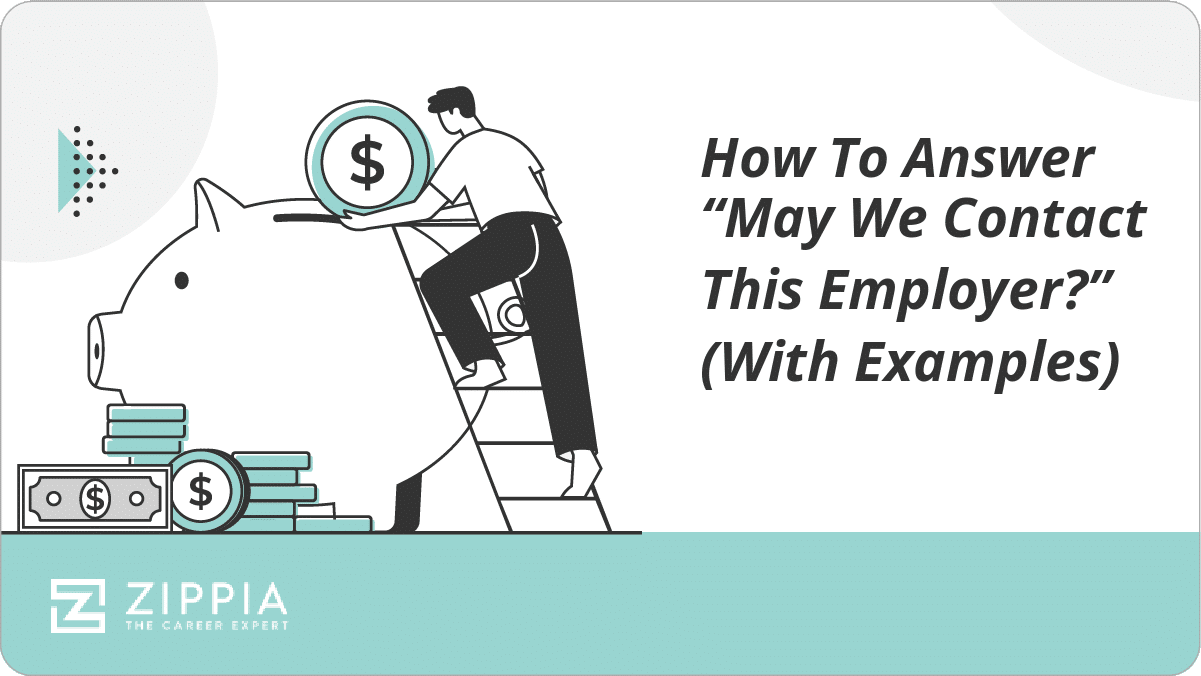
How To Answer “May We Contact This Employer?” (With Examples)

How To Write An Entry-Level Resume Objective (With Examples)

Police Officer Interview Questions And Answers (With Examples)
- Career Advice >
- Get The Job >
- 3 Tips Are You Willing To Travel
Please wait while your request is being verified...
How much Travel is 10% Travel in a job description?
You certainly have heard about the 10% Travel or seen it in the job description. What does the 10 percent travel mean, then?
It means that your employer expects you to spend 10 percent of your working days traveling or in cities other than your home city.
10% Travel : How to calculate travel percentage?
- How many days?
But how can one know the exact number of work days they will be spending in other countries or cities away from home?
It is very easy; you only have to do a quick calculation.
For instance, if your employer wants you to be traveling 10 percent of your working days – 260 days yearly on average – then you would expect to leave your office or town for 26 days each year.
- How many weeks?
Therefore, if you happen to work 50 weeks per year and need to go on five business trips per year, each lasting one week (e.g., to visit a client in the context of a project), this accounts for 10%.
- How many hours?
For the most part, let’s assume you work full time. This means that you will work 1,920 hours per year. Travel percentage is a percentage of the total number of hours or days you are willing to spend traveling.
For instance, if your employer requires you to be traveling at least 20% of the time, that would mean up to 384 hours of travel. Put another way, approximately 16 days per year.
You should double-check with your employer to see if this also applies to weekends or not. There is no problem if you tell your employer that you do not want to do any business travel on weekends.
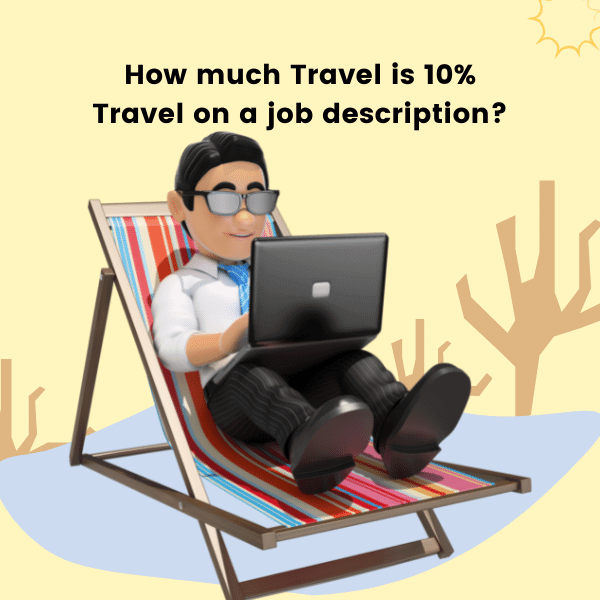
Is 10% travel too much travel?
No Mention Of Drug Tests In A Job Offer : Does that mean no test?
Effects of heavy traveling
Around 30% of working travelers say it is very difficult to stay healthy when they travel for work, and 24% say they are even more likely to get physically ill after a business trip.
Almost half of them don’t sleep enough when they travel for work, based on a new report by business travel management company TravelPerk.
The disruption that business travel causes to routine often leads to unhealthy eating and drinking, as well as a lack of physical activity. In addition, business travel can affect many people’s sleep, which in turn can jeopardize the immune system.
In addition, an estimated 30 percent feel they need to be constantly reachable while traveling for business, and 27 percent have trouble finding time for themselves and relaxing, according to the TravelPerk report.

According to a study last year, those who traveled 14 or more nights per month for work – as compared to those who traveled only one to six nights per month – had a higher body mass index and were more prone to symptoms such as anxiety, depression and alcohol dependence, the Harvard Business Review reported.
Meanwhile, those who traveled 21 or more nights per month for work were significantly more likely to be obese and experience higher blood pressure.
Needless to say, each company has very distinctive approaches and needs, so you should initiate the conversation with your employer.
Can “10% Travel” be considered heavy traveling?
Employers often indicate 10% travel time with almost no intention of actually asking it because it’s only required on an occasional basis.
So many people in these positions do not travel for years. But if an employer is actually considering regular travel, you need to find out what kind of frequency they really look for.
For the majority of workers, there is a world of difference between two one-day trips per month compared to a one-week trip per quarter or a five-week trip per year, all of which could reasonably be considered as 10% of travel time.
In a nutshell, 10 percent is a convenient and unproblematic travel rate for workers , which did not cause them any significant difficulties at work and did not affect them on either a personal or professional level.
Read also: When Is It Too Late To Cancel An Interview?
Is business travel compulsory?
The first labor law question arises even before the business trip begins. Is a business trip part of an employee’s duties at all, can the boss simply order the business trip, or can an employee refuse a business trip?
Particularly when children are involved or one is caring for one’s own parents, the business trip does not exactly cause shouts of joy.
Nevertheless, business trips are usually obligatory and not a free ride for the employee. In many areas, business travel is already part of the job description and is therefore always obligatory because the job can hardly be performed without business travel.
Classic examples of such professional areas that cannot do without business trips are sales, management, or field service.
On the other hand, the number of days for business travel is not strictly defined or precise but depends on the needs of the company. Sometimes employers just want to test your willingness to travel!
[Guide] Should I include therapy on my resume?
Can workers evolve from 10% travel to 50% travel?
The answer to this question is yes, employees love to travel! Some certainly prefer jobs that give them routine and allow them to always be near family and friends. But a surprising number of employees don’t see business travel as a burden.
30% would even accept a lower salary in exchange for being able to travel more during work hours ( Booking.com for Business ).
More than one-third of Millennials and Generation Z employees would not accept a job that did not offer them the opportunity to travel.
And according to another survey, 92% of business travelers are satisfied with their quality of life on the road. For those who are less inclined to travel, the reluctance to take business trips may also be linked to the process being too complicated with booking, payment methods on the road, and later travel expense reporting.
Regardless of the fact that employees love business travel when employers want to recognize the contributions of employees to the firm, they promote them to a higher position or role.
As employees get promoted to higher positions, they certainly may obtain more business travel opportunities as well. Thus, the percentage can rise from 10 to 20, 30, or even 50 percent.
Do all companies and all roles require business travel?
Not all companies and roles require you to frequently travel, it depends on the specific nature of your job itself.
The roles that necessitate business travel are divided into two categories, some are considered long-term careers, while others are contract positions allowing time for breaks between work assignments.
Here follows a list of the roles that entail business travel:
- International operations specialist
- Travel agent
- Training specialist
- Business consultant
- Travel technician
- Travel nurse
- Truck driver
- Flight attendant
- Train conductor
- Cruise ship chef
- Foreign language teacher
On the other hand, there is a good deal of jobs that require less to no travel at all.
The followings are an example:
- Community Manager
- Virtual assistant
- Home-based jewelry designer
- Home-based sports coach
- Independent Real Estate Agent
- Customer Service Representative
- Home-based hairdresser
- Distance learning trainer
How to answer “what percentage of travel are you willing to travel?
Always remember before you agree to job offers proposed by employers that there are other percentages for travel such as 20, 30, 50 and 70 percent as well.
If you are a travel and airport enthusiast and you have no problem with spending time away from home and from your city for work, you can disclose to your employer that you want to take on a new work experience.
In case the job offer and the travel percentage suit you well, you can use one of the following answers to your employer:
“Yes, this amount of travel suits me, I traveled as much time during my previous job and everything worked just fine”.
However, if you can not travel as much as what your employer proposes, you can simply say: “I don’t think I can travel that much time. It would be so much better to reduce the travel requirements to X% (the percentage that matches your preferences)” .
The following is what you probably should not mention when talking about business travel:
- Tell your interlocutor that it will make you reconsider the position.
- Talk about the bad travel experiences you have had in an earlier time.
- Change your attitude and become a little negative about the person you are talking to.
Leave a Reply Cancel reply
Your email address will not be published. Required fields are marked *
Save my name, email, and website in this browser for the next time I comment.

An official website of the United States government
Here's how you know
Official websites use .gov A .gov website belongs to an official government organization in the United States.
Secure .gov websites use HTTPS A lock ( Lock Locked padlock ) or https:// means you've safely connected to the .gov website. Share sensitive information only on official, secure websites.
How to complete any task on USAJOBS, step by step.
Manage Account
- Create a login.gov account
- Use login.gov if you have limited access to a phone or cell service
- Change the phone number you use to sign in
- Enter an international phone number when creating a login.gov account
- Update your primary email address
- Change or reset your password
- Sign into your account if you can't access your primary email
- Create a profile
- Delete a profile
- Fill out your education
- Answer questions about federal service
- Choose hiring paths in your profile
- Add languages in your profile
- Answer questions about military service
- Fill out your work experience
- Make your resume and profile searchable
Job announcement
- Understand a job announcement
- Understand announcement closing types
- Save a job announcement
- Remove a saved job announcement
- Contact an agency
Application
- Create an application
- Save an application
- Update an application
- Continue an application
- Check on the status of an application
- Archive an application
- Cancel an application
- View job applications
- Create a resume
- Build a resume
- Edit a resume
- Upload a resume
- Make a resume searchable
- Print a resume
- Upload documents
- Manage documents
- Fax documents
- Search by your preferences
- Save a search
- Sort search results
- Understand search results
- Unsubscribe from a saved search
Filter results by...
- Appointment type
- Hiring path
- Mission critical career field
- Security clearance
- Travel percentage
- Work schedule
- Zero job openings
Keyword and location
Get started.
USAJOBS posts all federal job opportunities with a position description and instructions how to apply. With USAJOBS.gov tools and resources, you can find the right federal job faster.
About USAJOBS
As the federal government's official employment site, USAJOBS has attracted over 16 million job seekers to create accounts to date.
You are here
Kidney failure, table of contents, about kidney failure, signs and symptoms, complications, medications, questions to ask, more resources.
Kidney failure means your kidneys are no longer able to work well enough to keep you alive. With kidney failure, 85-90% of your kidney function is gone. People with kidney failure have stage 5 CKD (also known as end-stage kidney disease or ESKD).
People with kidney failure will need dialysis or a kidney transplant to survive.
Kidney failure is a result of a gradual loss of kidney function. Some people do not even know they have kidney disease until they reach kidney failure. This is because people with early kidney disease may not feel sick at all. Symptoms usually show up later in advanced disease and may include:
- Urinating (peeing) less often than usual or not at all
- Itchy and/or dry skin
- Feeling tired
- Trouble concentrating
- Numbness or swelling in your arms, legs, ankles, or feet
- Achy muscles or cramping
- Shortness of breath
- Nausea and/or vomiting
- Loss of appetite
- Trouble sleeping
Healthy kidneys remove wastes and extra fluid from your body. They balance salts and minerals in your blood. They also help control blood pressure, make red blood cells, and keep bones strong. When kidneys go into kidney failure, they are unable to work as well as they should. As a result, wastes and excess fluid can build up in your body and make you feel sick.
The two main causes of kidney failure are diabetes and high blood pressure, which make up about two-thirds of cases. Other diseases can also lead to kidney failure, including IgA nephropathy , lupus nephritis , polycystic kidney disease , Fabry disease , and many others. Social and environmental factors also play a part in kidney disease.
Kidney failure can lead to other health problems or complications. Many people living with kidney failure have one or more complications. Kidney failure can increase your risk of heart disease or stroke. Other complications can include:
- Anemia (low levels of red blood cells)
- Metabolic acidosis (buildup of acid in the blood)
- Mineral and bone disorder (when blood levels of calcium and phosphorus are out of balance leading to bone and/or heart disease)
- Hyperkalemia (high levels of potassium in the blood)
Certain conditions can be both a cause and a complication (result) of kidney disease. These include high blood pressure, heart disease and stroke.
It is important to get regular check-ups to monitor these complications.
Urine and blood tests can check for signs of CKD. Estimated glomerular filtration rate ( eGFR ) is a blood test that checks how well the kidneys are filtering.
People with kidney failure have an eGFR of less than 15 for 3 months or more (confirmed with repeat testing to make sure you don’t have acute kidney injury ) or they are on dialysis.
You may also need extra tests to monitor other conditions related to kidney disease.
There is no cure for kidney failure, but with treatment it is possible to live a longer and productive life.
Dialysis and kidney transplant are the two treatments for people with kidney failure. Dialysis treatments or a transplanted kidney will take over some of the work from your damaged kidneys and remove wastes and extra fluid from your body. This will make many of your symptoms better. You also have the option to choose not to pursue either option, also known as “conservative management.”
- Dialysis : There are two types of dialysis- hemodialysis and peritoneal dialysis. Both remove waste products and extra fluid from your blood. Hemodialysis uses an artificial kidney machine, while peritoneal dialysis uses the lining in the belly. Hemodialysis treatments can be done at your home or in a clinic. Peritoneal dialysis is usually done at your home.
- Kidney transplant : A kidney transplant is an operation that places a healthy kidney in your body.
- Conservative management focuses on your quality of life and managing symptoms without dialysis or a kidney transplant. Conservative management is also called comfort care, non-dialytic care, supportive care, or comprehensive conservative care.
There are many things to consider when choosing a treatment for kidney failure, including lifestyle, health problems or the need for someone to assist you. Your decision should be based on your medical history, a healthcare professional’s opinion, and on what you and your family want. Learning about your treatment choices will help you decide which is best for you.
The medicines you take may change when have kidney failure. Many, but not all, medicines are removed from the blood by your kidneys, so it is important to speak with your healthcare team to make sure your medicines continue to be effective and safe. Also, check with your healthcare team before starting any supplements, herbal medicines, or other over-the-counter therapies to make sure they are safe.
People with kidney failure may need to take medicines or supplements to manage certain complications, as needed. Therapies can include iron, calcium, vitamin D, or medicines that lower phosphorus or potassium in the blood.
The dose or timing of certain medicines may need to be adjusted for people on dialysis. Certain drugs can be removed faster with the dialysis process. Some drugs also have the potential to build up in the blood for people on dialysis.
People with a kidney transplant will need to take anti-rejection medicines (or immunosuppressants ), which are drugs or medicines that lower the body's ability to reject a transplanted organ. Normally, the body fights off anything that isn’t part of itself, like germs and viruses. That system of protection is called the immune system. To stop the body from attacking or rejecting the donated kidney, anti-rejection medicines are needed to keep the immune system less active.
Nutrition and eating healthy are important parts of your health. Eating healthy generally includes having more fruits and vegetables, and eating foods that are less processed and as close to fresh as possible. A person with kidney failure may have their diet change over time. A dietitian can make recommendations and help you with any changes in the foods you eat.
People on dialysis will need to make sure they have the right amounts of protein and certain minerals. Protein can be lost with each dialysis treatment. As a result, people on dialysis may need to consume more protein. People on dialysis may also have to limit how much fluid is consumed. When kidneys do not work as well as they should, they are no longer able to remove extra fluid. If too much fluid builds up, it can have harmful effects on your health, such as difficulty breathing and swelling.
Generally, people with a kidney transplant do not have the same nutritional requirements or restrictions as do people on dialysis. Healthy eating is still important. You may need to change what you eat if you have any conditions such as high blood pressure or diabetes.
Nutrition and eating healthy can be a challenge for anyone, especially if you have kidney failure. A dietitian can help with a meal plan that’s right for you.
Exercise and physical activity, along with nutrition, are important parts of your health. The Centers for Disease Control and Prevention (CDC) recommends 150 minutes of physical activity per week, which can be done in any interval – spread it out. Don't confuse physical activity with vigorous exercise. Any type of body movement helps including walking, gardening, dancing or doing chores. The key is to find something that you enjoy and works best for you.
Check with your healthcare team before starting any exercise and ask which exercises are best for you.
What’s your story?
We want to hear about your unique experience with a kidney transplant, living donation, or kidney disease. Your story may be the one that gives someone hope.
- Are there any changes I need to make with my diet? Can a dietitian help me with my diet?
- Do I have to make any changes with my medications?
- When do you think I will need to start kidney failure treatment, such as dialysis or kidney transplant? Where do I start with this process? Do I need a referral?
- How can I start the process to be evaluated for a kidney transplant and get placed on a kidney transplant list?
- If I choose a kidney transplant, can I build wait time on the donor transplant list?
- If I choose dialysis, what types of dialysis are right for me?
- How do I prepare for the type of dialysis that I choose?
- Medicare Basics: End Stage Kidney Disease (ESKD)
- NKF Council on Renal Nutrition CKD Kidney Dietitian Directory
- NKF Transplants for All
This content is provided for informational use only and is not intended as medical advice or as a substitute for the medical advice of a healthcare professional.
Save this content:
Share this content:
Is this content helpful?
Back to top:
Numbers, Facts and Trends Shaping Your World
Read our research on:
Full Topic List
Regions & Countries
- Publications
- Our Methods
- Short Reads
- Tools & Resources
Read Our Research On:
What we know about unauthorized immigrants living in the U.S.
The unauthorized immigrant population in the United States reached 10.5 million in 2021, according to new Pew Research Center estimates. That was a modest increase over 2019 but nearly identical to 2017.
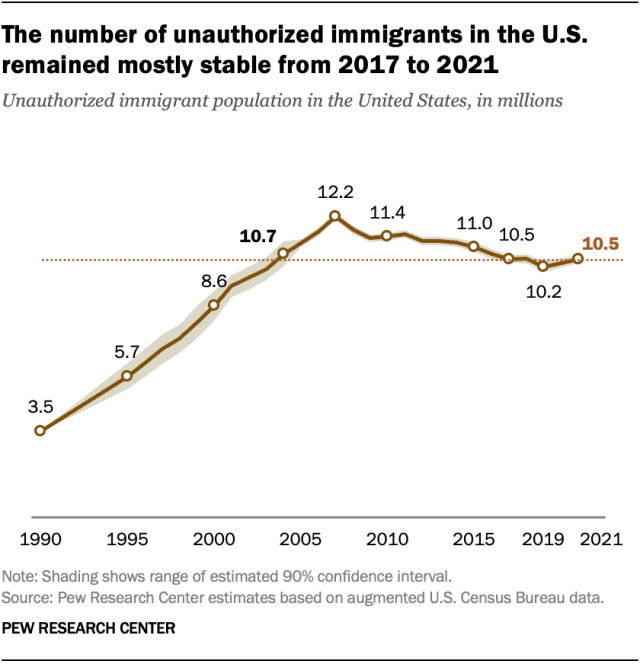
The number of unauthorized immigrants living in the U.S. in 2021 remained below its peak of 12.2 million in 2007. It was about the same size as in 2004 and lower than every year from 2005 to 2015.
The new estimates do not reflect changes that have occurred since apprehensions and expulsions of migrants along the U.S.-Mexico border started increasing in March 2021 . Migrant encounters at the border have since reached historic highs .
Pew Research Center undertook this research to understand ongoing changes in the size and characteristics of the unauthorized immigrant population in the United States. The Center has published estimates of the U.S. unauthorized immigrant population for more than two decades. The estimates presented in this research are the Center’s latest, adding new and updated annual estimates for 2017 through 2021.
Center estimates of the unauthorized immigrant population use a “residual method.” It is similar to methods used by the U.S. Department of Homeland Security’s Office of Immigration Statistics and nongovernmental organizations, including the Center for Migration Studies and the Migration Policy Institute . Those organizations’ estimates are generally consistent with ours. Our estimates also align with official U.S. data sources, including birth records, school enrollment figures and tax data, as well as Mexican censuses and surveys.
Our “residual” method for estimating the nation’s unauthorized immigrant population includes these steps:
- Estimate the total number of immigrants living in the country in a particular year using data from U.S. censuses and government surveys such as the American Community Survey and the Current Population Survey.
- Estimate the number of immigrants living in the U.S. legally using official counts of immigrant and refugee admissions together with other demographic data (for example, death and out-migration rates).
- Subtract our estimate of lawful immigrants from our estimate of the total immigrant population . This provides an initial estimate of the unauthorized immigrant population .
Our final estimate of the U.S. unauthorized immigrant population, as well as estimates for lawful immigrants, includes an upward adjustment. We do this because censuses and surveys tend to miss some people . Undercounts for immigrants, especially unauthorized immigrants, tend to be higher than for other groups. (Our 1990 estimate comes from work by Robert Warren and John Robert Warren; details can be found here .)
The term “unauthorized immigrant” reflects standard and customary usage by many academic researchers and policy analysts. The U.S. Department of Homeland Security’s Office of Immigration Statistics also generally uses it. The term means the same thing as undocumented immigrants, illegal immigrants and illegal aliens.
For more details on how we produced our estimates, read the Methodology section of our November 2018 report on unauthorized immigrants.
The unauthorized immigrant population includes any immigrants not in the following groups:
- Immigrants admitted for lawful residence (i.e., green card admissions)
- People admitted formally as refugees
- People granted asylum
- Former unauthorized immigrants granted legal residence under the 1985 Immigration Reform and Control Act
- Immigrants admitted under any of categories 1-4 who have become naturalized U.S. citizens
- Individuals admitted as lawful temporary residents under specific visa categories
Read the Methodology section of our November 2018 report on unauthorized immigrants for more details.
Pew Research Center’s estimate of unauthorized immigrants includes more than 2 million immigrants who have temporary permission to be in the United States. (Some also have permission to work in the country.) These immigrants account for about 20% of our national estimate of 10.5 million unauthorized immigrants for 2021.
Although these immigrants have permission to be in the country, they could be subject to deportation if government policy changes. Other organizations and the federal government also include these immigrants in their estimates of the U.S. unauthorized immigrant population.
Immigrants can receive temporary permission to be in the U.S. through the following ways:
Temporary Protected Status (TPS)
In 2021, there were about 500,000 unauthorized immigrants with Temporary Protected Status . This status provides protection from removal or deportation to individuals who cannot safely return to their country because of civil unrest, violence or natural disaster.
Deferred Enforced Departure (DED) is a similar program that grants protection from removal. The number of immigrants with DED is much smaller than the number with TPS.

Deferred Action for Childhood Arrivals (DACA)
Deferred Action for Childhood Arrivals is a program that offers protection from deportation to individuals who were brought to the U.S. as children before June 15, 2007. As of the end of 2021, there were slightly more than 600,000 DACA beneficiaries , largely immigrants from Mexico.
Asylum applicants
Individuals who have applied for asylum but are awaiting a ruling are not legal residents yet but cannot be deported. There are two types of asylum claims, defensive and affirmative .
Defensive asylum applications are generally filed by individuals facing deportation or removal from the U.S. These are processed by the Department of Justice’s Executive Office for Immigration Review. At the end of 2021, there were almost 600,000 applications pending.
Affirmative asylum claims are made by individuals already in the U.S. who are not in the process of being deported or removed. These claims are handled by the U.S. Department of Homeland Security’s Citizenship and Immigration Services (USCIS). At the end of 2021, more than 400,000 applications for affirmative asylum were pending, some covering more than one applicant.
Here are key findings about how the U.S. unauthorized immigrant population changed from 2017 to 2021:
- The most common country of birth for unauthorized immigrants is Mexico. However, the population of unauthorized immigrants from Mexico dropped by 900,000 from 2017 to 2021 , to 4.1 million.
- There were increases in unauthorized immigrants from nearly every other region of the world – Central America, the Caribbean, South America, Asia, Europe and sub-Saharan Africa.
- Among U.S. states, only Florida and Washington saw increases to their unauthorized immigrant populations , while California and Nevada saw decreases. In all other states, unauthorized immigrant populations were unchanged.
- 4.6% of U.S. workers in 2021 were unauthorized immigrants , virtually identical to the share in 2017.
Trends in the U.S. immigrant population
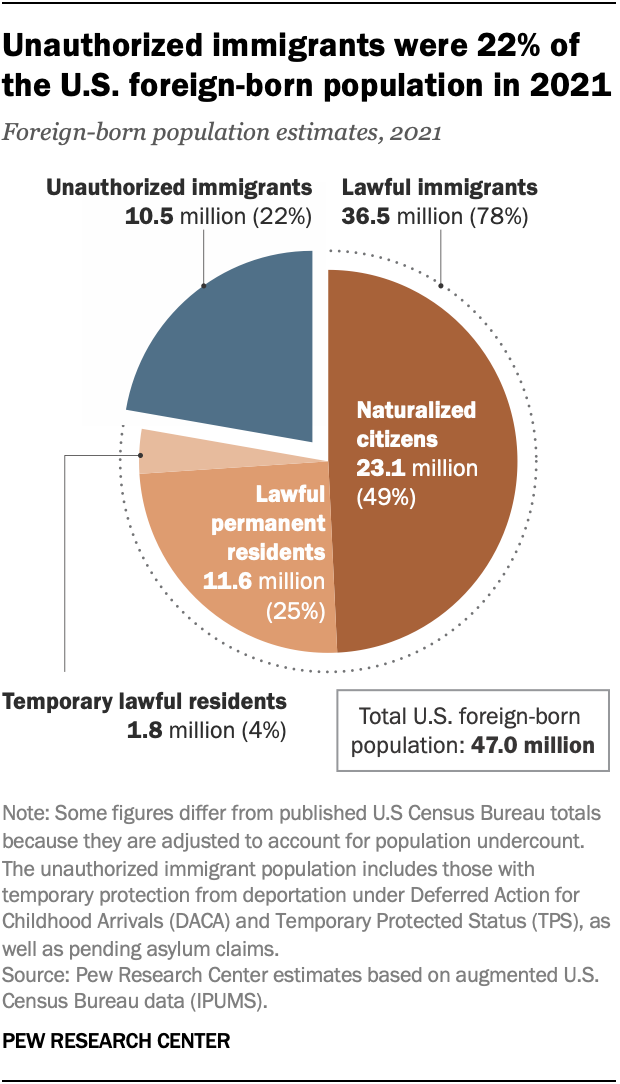
The U.S. foreign-born population was 14.1% of the nation’s population in 2021. That was very slightly higher than in the last five years but below the record high of 14.8% in 1890.
As of 2021, the nation’s 10.5 million unauthorized immigrants represented about 3% of the total U.S. population and 22% of the foreign-born population. These shares were among the lowest since the 1990s.
Between 2007 and 2021, the unauthorized immigrant population decreased by 1.75 million, or 14%.
Meanwhile, the lawful immigrant population grew by more than 8 million, a 29% increase, and the number of naturalized U.S. citizens grew by 49%. In 2021, naturalized citizens accounted for about half (49%) of all immigrants in the country.
Where unauthorized immigrants come from
Unauthorized immigrants living in the U.S. come from many parts of the world, with Mexico being the most common origin country.
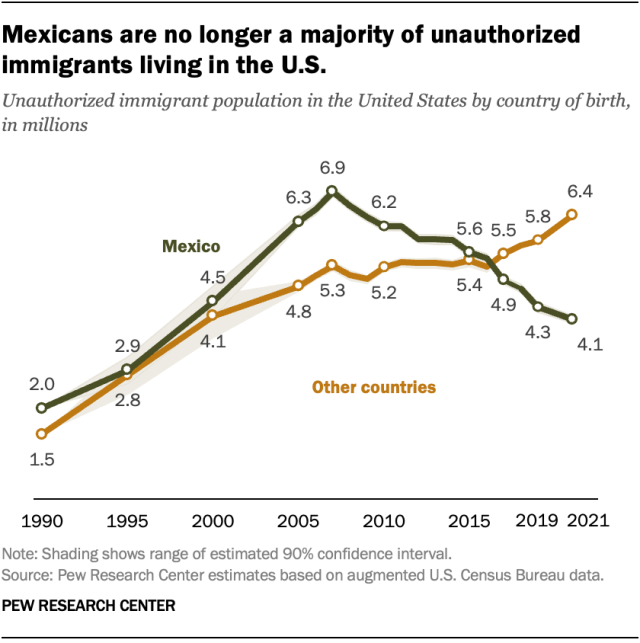
The origin countries for unauthorized immigrants have changed since the population peaked in 2007, before the Great Recession slowed immigration. Here are some highlights of those changes:
The number of unauthorized immigrants from Mexico living in the U.S. (4.1 million in 2021) was the lowest since the 1990s. Mexico accounted for 39% of the nation’s unauthorized immigrants in 2021, by far the smallest share on record .
The decrease in unauthorized immigrants from Mexico reflects several factors:
- A broader decline in migration from Mexico to the U.S.
- Mexican immigrants to the U.S. continuing to return to Mexico
- Expanded opportunities for lawful immigration from Mexico and other countries, especially for temporary agricultural workers.
The rest of the world
The total number of unauthorized immigrants in the U.S. from countries other than Mexico has grown rapidly. In 2021, this population was 6.4 million, up by 900,000 from 2017.
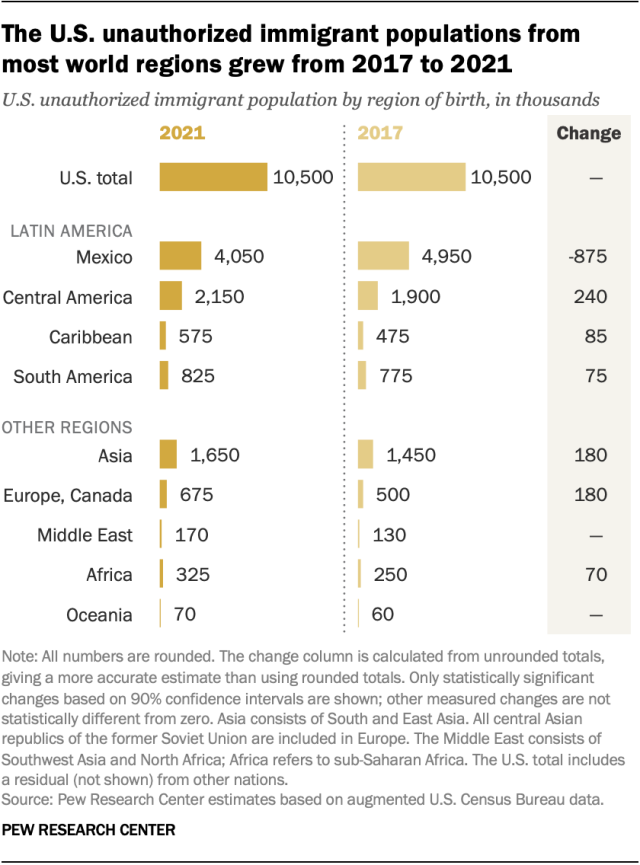
Almost every region in the world had a notable increase in the number of unauthorized immigrants in the U.S. from 2007 to 2021. The largest increases were from Central America (240,000) and South and East Asia (180,000).
After Mexico, the countries of origin with the largest unauthorized immigrant populations in the U.S. in 2021 were:
- El Salvador (800,000)
- India (725,000)
- Guatemala (700,000)
- Honduras (525,000)
India, Guatemala and Honduras all saw increases from 2017.
The Northern Triangle
Three Central American countries – El Salvador, Honduras and Guatemala – together represented 2.0 million unauthorized immigrants in the U.S. in 2021, or almost 20% of the total. The unauthorized immigrant population from the Northern Triangle grew by about 250,000 from 2017 and about 700,000 from 2007.
Other origin countries
Venezuela was the country of birth for 190,000 U.S. unauthorized immigrants in 2021. This population saw particularly fast growth, from 130,000 in 2017 and 55,000 in 2007.
Among countries with the largest numbers of U.S. unauthorized immigrants, India, Brazil, Canada and former Soviet Union countries all experienced growth from 2017 to 2021.
Some origin countries with significant unauthorized immigrant populations showed no change, notably China (375,000) and the Dominican Republic (230,000).
Detailed table: Unauthorized immigrant population by region and selected country of birth (and margins of error), 1990-2021 (Excel)
U.S. states of residence of unauthorized immigrants
The unauthorized immigrant population in most U.S. states stayed steady from 2017 to 2021. However, four states saw significant changes:
- Florida (+80,000)
- Washington (+60,000)
- California (-150,000)
- Nevada (-25,000)
States with the most unauthorized immigrants
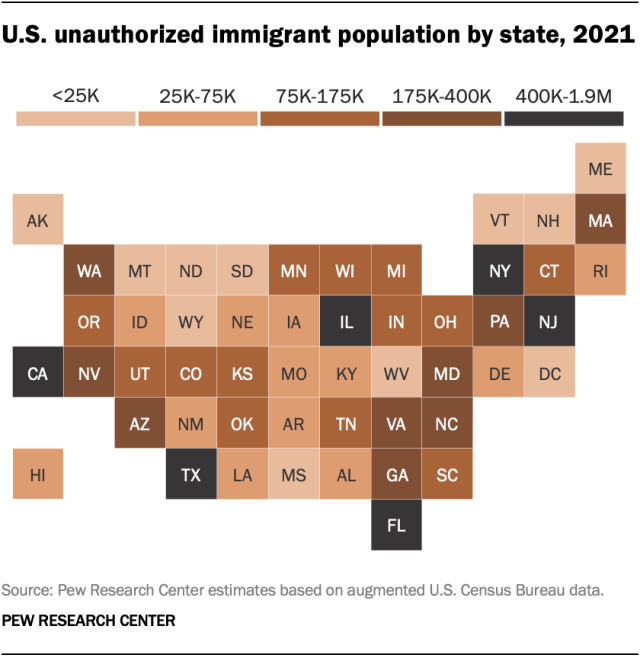
The six states with the largest unauthorized immigrant populations in 2021 were:
- California (1.9 million)
- Texas (1.6 million)
- Florida (900,000)
- New York (600,000)
- New Jersey (450,000)
- Illinois (400,000)
These states have consistently had the most unauthorized immigrants since 1990 and earlier .
At the same time, the unauthorized immigrant population has become less geographically concentrated. In 2021, these six states were home to 56% of the nation’s unauthorized immigrants, down from 80% in 1990.
Detailed table: Unauthorized immigrant population for states (and margins of error), 1990-2021 (Excel)
Detailed table: Unauthorized immigrants and characteristics for states, 2021 (Excel)
Unauthorized immigrants in the labor force
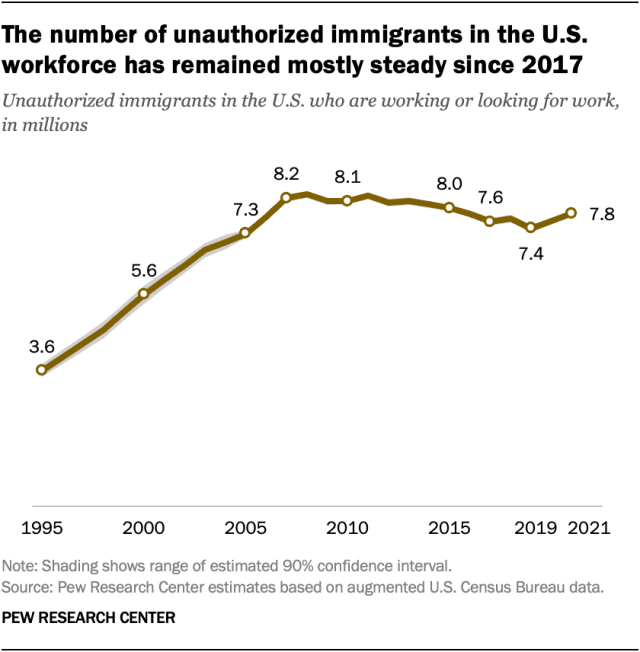
The share of unauthorized immigrants in the U.S. workforce was slightly less than 5% in 2021, compared with 3% of the total U.S. population.
Demographics help explain the difference: The unauthorized immigrant population includes relatively few children or elderly adults, groups that tend not to be in the labor force.
Overall, about 7.8 million unauthorized immigrants were in the U.S. labor force in 2021. That was up slightly from 2019 but smaller than every year from 2007 through 2015.
Detailed table: Unauthorized immigrants in the labor force for states, 2021 (Excel)
Here are some additional findings about unauthorized immigrants as a share of the workforce nationwide and in certain states:
- Since 2003, unauthorized immigrants have made up 4.4% to 5.4% of all U.S. workers, a relatively narrow range.
- Fewer than 1% of workers in Maine, Montana, Vermont and West Virginia in 2021 were unauthorized immigrants.
- Nevada (9%) and Texas (8%) had the highest shares of unauthorized immigrants in the workforce.
- Immigrant Populations
- Immigration Issues
- Unauthorized Immigration

Key facts about Asian Americans living in poverty
Latinos’ views on the migrant situation at the u.s.-mexico border, key facts about the nation’s 47.9 million black americans, key facts about the wealth of immigrant households during the covid-19 pandemic, 8 facts about recent latino immigrants to the u.s., most popular.
1615 L St. NW, Suite 800 Washington, DC 20036 USA (+1) 202-419-4300 | Main (+1) 202-857-8562 | Fax (+1) 202-419-4372 | Media Inquiries
Research Topics
- Age & Generations
- Coronavirus (COVID-19)
- Economy & Work
- Family & Relationships
- Gender & LGBTQ
- Immigration & Migration
- International Affairs
- Internet & Technology
- Methodological Research
- News Habits & Media
- Non-U.S. Governments
- Other Topics
- Politics & Policy
- Race & Ethnicity
- Email Newsletters
ABOUT PEW RESEARCH CENTER Pew Research Center is a nonpartisan fact tank that informs the public about the issues, attitudes and trends shaping the world. It conducts public opinion polling, demographic research, media content analysis and other empirical social science research. Pew Research Center does not take policy positions. It is a subsidiary of The Pew Charitable Trusts .
Copyright 2024 Pew Research Center
Terms & Conditions
Privacy Policy
Cookie Settings
Reprints, Permissions & Use Policy
2024 federal budget's key takeaways: Housing and carbon rebates, students and sin taxes
Budget sees nearly $53b in new spending over the next 5 years.

What's in the new federal budget?
Social sharing.
Finance Minister Chrystia Freeland today tabled a 400-page-plus budget her government is pitching as a balm for anxious millennials and Generation Z.
The budget proposes $52.9 billion in new spending over five years, including $8.5 billion in new spending for housing. To offset some of that new spending, Ottawa is pitching policy changes to bring in new revenue.
Here are some of the notable funding initiatives and legislative commitments in budget 2024.
Ottawa unloading unused offices to meet housing targets
One of the biggest pillars of the budget is its housing commitments. Before releasing the budget, the government laid out what it's calling Canada's Housing Plan — a pledge to "unlock" nearly 3.9 million homes by 2031.

The government says two million of those would be net new homes and it believes it can contribute to more than half of them.
It plans to do that by:
- Converting underused federal offices into homes. The budget promises $1.1 billion over ten years to transform 50 per cent of the federal office portfolio into housing.
- Building homes on Canada Post properties. The government says the 1,700-plus Canada Post offices across the country can be used to build new homes while maintaining postal services. The federal government says it's assessing six Canada Post properties in Quebec, Alberta and British Columbia for development potential "as a start."
- Rethinking National Defence properties. The government is promising to look at redeveloping properties and buildings on National Defence lands for military and civilian use.
- Building apartments. Ottawa is pledging a $15 billion top-up to the Apartment Construction Loan Program, which says it will build 30,000 new homes across Canada.
Taxing vacant land?
As part of its push on housing, the federal government also says it's looking at vacant land that could be used to build homes.
It's not yet committing to new measures but the budget says the government will consider introducing a new tax on residentially zoned vacant land.
- Freeland's new federal budget hikes taxes on the rich to cover billions in new spending
- Are you renting with no plans to buy? Here's what the federal budget has for you
The government said it plans to launch consultations on the measure later this year.
Help for students
There's also something in the budget for students hunting for housing.

The government says it will update the formula used by the Canada Student Financial Assistance Program to calculate housing costs when determining financial need, to better reflect the cost of housing in the current climate.
The government estimates this could deliver more aid for rent to approximately 79,000 students each year, at an estimated cost of $154.6 million over five years.
- Updated Federal budget's funding boost for defence spread out over multiple years
- Liberals pledge $9B in new money for Indigenous communities in 2024 budget
The government is also promising to extend increased student grants and interest-free loans, at an estimated total cost of $1.1 billion this year.
Increase in taxes on capital gains
To help cover some of its multi-billion dollar commitments, the government is proposing a tax hike on capital gains — the profit individuals make when assets like stocks and second properties are sold.
The government is proposing an increase in the taxable portion of capital gains, up from the current 50 per cent to two thirds for annual capital gains over $250,000.
New investment to lead 'housing revolution in Canada,' Freeland says
Freeland said the change would impact the wealthiest 0.1 per cent.
There's still some protection for small businesses. There's been a lifetime capital gains exemption which allows Canadians to exempt up to $1,016,836 in capital gains tax-free on the sale of small business shares and farming and fishing property. This June the tax-free limit will be increased to $1.25 million and will continue to be indexed to inflation thereafter, according to the budget.
The federal government estimates this could bring in more than $19 billion over five years, although some analysts are not convinced.
Disability benefit amounts to $200 per month
Parliament last year passed the Canada Disability Benefit Act, which promised to send a direct benefit to low-income, working-age people with disabilities.
Budget 2024 proposes funding of $6.1 billion over six years, beginning this fiscal year, and $1.4 billion per year ongoing, for a new Canada Disability Benefit.
Advocates had been hoping for something along the lines of $1,000 per month per person . They'll be disappointed.
According to the budget document, the maximum benefit will amount to $2,400 per year for low income individuals with disabilities between the ages of 18 and 64 — about $200 a month.
- Federal government plans to lease public lands for construction through new housing strategy
- Alberta premier says she's prepared to take Ottawa to court over housing deals
The government said it plans for the Canada Disability Benefit Act to come into force in June 2024 and for payments to start in July 2025.
Carbon rebate for small businesses coming
The federal government has heard an earful from small business advocates who accuse it of reneging on a promise to return a portion of carbon pricing revenues to small businesses to mitigate the tax's economic costs.
- What's behind the carbon tax, and does it work?
- Federal government scales back carbon tax rebates for small businesses
The budget proposes to return fuel charge proceeds from 2019-20 through 2023-24 to an estimated 600,000 businesses with 499 or fewer employees through a new refundable tax credit.
The government said this would deliver $2.5 billion directly to Canada's small- and medium-sized businesses.
Darts and vape pods will cost more
Pitching it as a measure to cut the number of people smoking and vaping, the Liberals are promising to raise revenues on tobacco and smoking products.
- Just Asking wants to know: What questions do you have about quitting smoking or vaping? Do you think sin taxes will encourage smoking cessation? Fill out the details on this form and send us your questions ahead of our show on April 20.
Starting Wednesday, the total tobacco excise duty will be $5.49 per carton. The government estimates this could increase federal revenue by $1.36 billion over five years starting in 2024-25.

The budget also proposes to increase the vaping excise duty rates by 12 per cent effective July 1. That means an increase of 12 to 24 cents per pod, depending on where you live.
- 'Stay the hell away from our kids': Health minister vows to restrict nicotine pouches — but how?
Ottawa hopes this increase in sin taxes will bring in $310 million over five years, starting in 2024-25.
More money for CBC
Heritage Minister Pascale St-Onge has mused about redefining the role of the public broadcaster before the next federal election . But before that happens, CBC/Radio-Canada is getting a top-up this year.

The budget promises $42 million more in 2024-25 for CBC/Radio-Canada for "news and entertainment programming." CBC/Radio-Canada received about $1.3 billion in total federal funding last year.
The government says it's doing this to ensure that Canadians across the country, including rural, remote, Indigenous and minority language communities, have access to independent journalism and entertainment.
Last year, the CBC announced a financial shortfall, cut 141 employees and eliminated 205 vacant positions. In a statement issued Tuesday, CBC spokesperson Leon Mar said the new funding means the corporation can balance its budget "without significant additional reductions this year."
Boost for Canada's spy agency

As the government takes heat over how it has handled the threat of foreign election interference, it's promising more money to bolster its spy service.
The Canadian Security Intelligence Service is in line to receive $655.7 million over eight years, starting this fiscal year, to enhance its intelligence capabilities and its presence in Toronto.
- CSIS chief defends his spies' work after PM casts doubt on reliability of agency's reports
- Trudeau says it's his job to question CSIS intelligence, call out 'contradictions'
The budget also promises to guarantee up to $5 billion in loans for Indigenous communities to participate in natural resource development and energy projects in their territories.
These loans would be provided by financial institutions or other lenders and guaranteed by the federal government, meaning Indigenous borrowers who opt in could benefit from lower interest rates, the budget says.
ABOUT THE AUTHOR

Catharine Tunney is a reporter with CBC's Parliament Hill bureau, where she covers national security and the RCMP. She worked previously for CBC in Nova Scotia. You can reach her at [email protected]
- Follow Cat on Twitter
Add some “good” to your morning and evening.
Your weekly guide to what you need to know about federal politics and the minority Liberal government. Get the latest news and sharp analysis delivered to your inbox every Sunday morning.
Credit Cards
Investments
Accounts Overview
RBC Vantage
Explore Account Types
Chequing Accounts
Cross-Border Banking
Savings Account
Youth and Student Banking
Earn More with RBC
Value Program
Chequing Products
Advantage Banking
Advantage Banking for Students
Day to Day Banking
Signature No Limit Banking
VIP Banking
US Personal Banking
Savings Products
High Interest eSavings
Enhanced Savings
Day to Day Savings
Leo’s Young Savers Account
Tools & Resources
Account Selector Tool
Compare Chequing Accounts
Compare Saving Accounts
Customer Service
Managing Your Bank Account
Wire Transfer
International Money Transfer
Virtual Visa Debit
Direct Deposit
Additional Account Services
Get the new Apple Watch with an eligible RBC bank account
Credit Cards Overview
View All Credit Cards
Travel Cards
Rewards Cards
Cash Back Cards
Low Interest Cards
No Annual Fee Cards
Student Cards
Business Cards
Help me Choose a Credit Card
Company Credit Cards
Credit Card Cash Back Calculator
Frequently Asked Questions
Cards Advice: How Do I…
Improve my credit score
Reduce my credit card interest
Pay my credit card bill
Manage expenses with credit cards
Protect from credit card fraud
I’m a Cardholder
Activate My Card
Cardholder Resources
Report Lost or Stolen Credit Card
Add an Additional User
Benefit Guides and Insurance Documents
Optional Add-On Services
Three Simple Ways to Keep your Money Safe from Fraud and Scams
Mortgages Overview
Mortgage Rates
Mortgage Products
Manage Your Mortgage
Special Mortgage Offers
Connect with a Mortgage Specialist
Get Pre-Qualified in 60 Seconds
Your Next Move
Buy Your First Home
Buying Your Next Home
Renovate Your Home
Buying an Investment Property
Buying a Vacation Home
Renew Your Mortgage
Switch Your Mortgage to RBC
Refinance Your Mortgage
Mortgage Payment Calculator
Home Value Estimator
Neighbourhood Explorer
Rent or Buy Calculator
All Mortgage Tools & Calculators
RBC Homebuyer Advantage
Limited Time Offer: Get up to $3,500 and 55,000 Avion points, only with an eligible RBC mortgage.*
Personal Loans
Loans Overview
Lines of Credit
Student Lines of Credit
Home Improvement Loans
Car Loans & Vehicle Solutions
Car Loans Overview
Car Loans Through a Dealer
Loans for Electric Vehicles
Financing Your Boat or RV
Business Vehicle Solutions
Buying Your First Vehicle
Buying Your Next Vehicle
Managing Your Car Loan
Car Loan Prequalify Calculator
Tools & Calculators
My Auto Affordability Tool
Car Loan Calculator
RV & Marine Locator
Loan Payment Calculator
Debt Consolidation Calculator
Compare Lines of Credit & Loans
Pay Down Debt & Improve Cash Flow
Loan Calculators
Get Pre-Qualified for an RBC Automotive Loan Today
Savings and Investments Overview
Popular Accounts & Products 1
Tax-Free Savings – TFSA
Retirement Savings – RRSP
First Home Savings – FHSA
Education Savings – RESP
Guaranteed Investment Certificate – GICs
Mutual Funds
Exchange-Traded Funds – ETFs
Stocks and Bonds (RBC Direct Investing)
ESG Investing
All Investments Accounts and Products
Ways to Invest
With Access to an Advisor
Low-Efffort, Automatic Investing (RBC InvestEase)
Trade and Invest Yourself (RBC Direct Investing)
Purchase Investments
Advice and Planning
How to Save and Invest Guides
Retirement Planning
Financial Planning (RBC Financial Planning)
Customized Wealth Planning (RBC Wealth Management)
Resources and Tools
All Investment Tools & Calculators
TFSA Calculator
RRSP Calculator
GIC Selector
Compare GICs
Retirement Budget Calculator
Save for your first home, tax-free. Open a First Home Savings Account Today!
1 Products and services may be offered by Royal Bank of Canada or by a separate corporate entity affiliated with Royal Bank of Canada, including but not limited to Royal Mutual Funds Inc., RBC Direct Investing Inc. (Member–Canadian Investor Protection Fund), RBC InvestEase Inc., RBC Global Asset Management Inc., Royal Trust Company or The Royal Trust Corporation of Canada
Insurance Overview
Creditor Insurance
Creditor Insurance Overview
HomeProtector Insurance
LoanProtector Insurance
BalanceProtector Insurance
Travel Insurance
Travel Insurance Overview
Travel Insurance Packages
Travel Medical Insurance
Trip Cancellation and Interruption Insurance
Get a Quote
Creditor Protection Selector
HomeProtector Insurance Quote
LoanProtector Insurance Quote
Make a Travel Insurance Claim
Ways to Bank
Student Solutions
Beyond Banking
Sustainable Finance Solutions
Ways to Bank Overview
Online Banking
ATM, Branch, & Telephone Banking
RBC Digital Banking Security Guarantee
Mobile Banking apps
Avion Rewards
Pay with Your Mobile Device
Learn How To…
Reset Your Password
View or Print a Void Cheque
Add or Remove a Payee
Set up Direct Deposit
Transfer Money Between Accounts
View or Print Your Tax Documents
View All Tutorials
Newcomers Overview
The RBC Newcomer Advantage
Advice by Visa Status
Permanent Resident
International Student
Business Owner/Entrepreneur
Foreign Worker
What Our Partners Can Offer You
How Banking Works in Canada
Building a Credit History in Canada
Buying Your First Home in Canada Checklist
Buying Your First Car in Canada Checklist
Retirement Overview
I’m Saving and Planning
I’m Getting Close
I am Already Retired
Retirement FAQ
Tools and Resources
Test Your Retirement Knowledge
Will and Estate Planning
What is CPP and QPP?
Tailored Products & Offers
Retirement Income Fund – RRIF
Student Hub
Student Bank Accounts
Student Credit Cards
Student Loans
Popular Accounts
RBC Advantage Banking for Students
RBC High Interest eSavings
RBC Leo’s Young Savers Account
Build Your Career
Future Launch
Gain New Skills
Grow Your Network
Work Experience
Personal Beyond Banking
Business Beyond Banking

Arrive: For Newcomers to Canada
Learn More About Arrive
Sustainable Finance Solutions Overview
Switch to Electronic Statements
Savings & Investments
Travel & Commuting
Electric Car Financing
Electric Car Cost Calculator
Electric Car Guide
Electric Car Rebates
Home Energy Rebates
Rewards Overview
Avion Rewards Credit Cards
Pay with Points
RBC Petro-Canada
Rewards Credit Cards
Popular Rewards Cards
RBC Avion Visa Infinite
RBC ION Visa
RBC Avion Visa Infinite Privilege
RBC ION+ Visa
What’s New
View Offers
#LifeMatters: Bryan Baeumler on Choosing a Path Less Travelled
- My Money Matters
Struggling to Make Ends Meet
Managing and Consolidating Debt
Managing Expenses
Improving Your Credit Score
Unexpected Events
Loss of Income
Handling Financial Stress
Money in an Emergency
Personal Bankruptcy
Business Bankruptcy
Consumer Proposals
Need Financial Help?
Book an Appointment
1 800 769-2511
Buying a Home
Buying your First Home
Buying your Next Home
Investment Property and Vacation Home
Home Building and Renovations
Refinancing and Downsizing
Buying a Vehicle
Finding the Right Car
Financing Your Car
Travel and Cross-Border
Planning for a Big Trip
Buying or Refinancing a US property
Travelling and Shopping in the US
Studying in the US
Living in the US
School and Career
Going to College or University
Finding a Job
Continuing Education
Medical or Dental Students
Planning for Retirement
Living in Retirement
Family Events
Death of a family member
New to Canada
Settling in Canada
Employment in Canada
Banking in Canada
Studying in Canada
Starting a Business in Canada
Settling into your new life in Canada can be hard. Talk to an RBC Newcomer Advisor
Banking Basics
Account Types
Banking Tips
Money Mindset
Credit and Borrowing
Understanding Loans
Understanding Credit Scores
Understanding Credit Cards
Types of Investments
Understanding Risk
Investing Basics
Cyber Security
Understanding Cyber Safety
Cyber Security for Business
Economics 101
Economics for Beginners
Understanding Inflation
Understanding Interest Rates
Climate Change
Business Stages
Start a Business
Grow Your Business
Transition Your Business
Managing Your Business
Business Planning
Business Financing & Funding
Cash Flow Management & Financials
Making & Receiving Payments
Get Inspired
Business Success Stories
Right-Sized Business Advice
Small Business
Solo Entrepreneur
Ideas & Voices
Go To Grandma with Kathy Buckworth
Real Life Stories of Cyber Crime
Take 2 Minutes
The Wealthy Barber
Inspired Investor
Ideas & Motivation
Investing Academy
Smart Savings
What’s your money mindset?
Finance, Fitness and your Future
- Institutional
- Global Asset Management
- Capital Markets
- Investor Services
- Find a Branch
- Call 1-800-769-2511
- English (Canada)
- Français (Canada)
Federal Budget 2024: What are the proposed capital gains tax changes and how might they affect me?
By Diane Amato

Share this:
Published April 19, 2024 • 4 Min Read
Canada’s recently unveiled 2024 budget proposes to adjust the capital gains inclusion rate. What does this mean for investors and taxpayers? Read on to find out how these changes might affect you.
When you sell an asset or investment for more than it cost you, you have a capital gain
Today, 50% of capital gains are taxable for all individuals and businesses
As of June 25, the capital gains tax inclusion rate is set to increase from 50% to 66.67% for all capital gains realized by corporations and trusts, and for capital gains over $250,000 realized by individuals
What are capital gains?
When you sell an asset or investment for more than you paid for it, that difference is your capital gain. For example, say you bought a cottage for $400,000 and two years later, sold it for $500,000. You have a capital gain of $100,000. On the flip side, when you sell an asset for less than you bought it for, you have a capital loss.
You can realize capital gains and losses on several types of investments and property, including stocks, bonds, shares in mutual funds, rental properties, cottages, even business equipment. Capital gains and losses do not apply to your primary residence.
What is capital gains tax?
In Canada, capital gains are taxable. How much tax you pay depends on a few factors. That’s because the value of a capital gain is treated as income during the year in which you realized it – in other words, in the year you sold your investment or property. But it’s not the full value of the gain that gets taxed – rather it’s only a portion.
The capital gains tax inclusion rate – today and tomorrow
Today, only 50% of the capital gain is taxable (this is known as the capital gains tax inclusion rate). This means that $50,000 of the $100,000 earned from the sale of the cottage in our example is added as income for that tax year.
Here’s an example:
Your regular income, earned from your full-time job, is $75,000
You make a $100,000 profit from the sale of your cottage (after you pay real estate fees, closing costs, etc.)
50% of the profit is taxable, which means you add $50,000 to your income during the tax year in which you realized this capital gain
$75,000 + $50,000 = a total income for that tax year of $125,000
The amount of tax you ultimately pay in that year will depend on your tax bracket and its marginal tax rate.
If this budget is passed, the capital gains tax inclusion rate is set to change. The federal government’s 2024 budget proposes a few modifications to how capital gains are taxed. Here’s a rundown of the changes:
For all corporations and trusts , the capital gains tax inclusion rate will increase to 66.67% – up from 50%.
For individuals with gains over $250,000 , the capital gains tax inclusion rate will increase to 66.67% – up from 50%.
For individuals with gains under $250,000 , the capital gains tax inclusion rate will stay the same, 50%.
Who will the changes affect?
The adjustments will affect all corporations and trusts regardless of value, as well as individuals with capital gains of $250,000 or more.
Capital gains tax does not apply to your primary residence, so you these changes could affect you if:
You sell a secondary property – such as a cottage, rental or investment property – and earn more than $250,000 in profit from that sale.
You sell investments for a value of $250,000 more than the original purchase price.
When will the changes take effect?
If adopted, the changes will take effect on June 25, 2024.
The federal government estimates that 28.5 million Canadians will not have any capital gains income next year, while three million others will fall below the $250,000 annual threshold, suggesting that these changes will not have an impact on the majority of Canadians.
If you believe they will affect you and your finances, it may be worth speaking with a qualified tax advisor and financial planner to learn strategies to reduce the impact of capital gains taxes and the proposed increased inclusion rate.
Things our lawyers want you to know Things our lawyers want you to know
This article is intended as general information only and is not to be relied upon as constituting legal, financial or other professional advice. A professional advisor should be consulted regarding your specific situation. Information presented is believed to be factual and up-to-date but we do not guarantee its accuracy and it should not be regarded as a complete analysis of the subjects discussed. All expressions of opinion reflect the judgment of the authors as of the date of publication and are subject to change. No endorsement of any third parties or their advice, opinions, information, products or services is expressly given or implied by Royal Bank of Canada or any of its affiliates.
Share This Article
Read This Next

Helping Others by Promoting Empowerment
How to Answer “Are You Willing to Travel?” (Interview Question)

If a job involves any travel, you’re likely to hear interview questions like, “Are you willing to travel?” “How much are you willing to travel?” etc.
So in this article, I’m going to walk you through how to answer all of these interview questions.
And we’ll look at how to understand the meaning of “travel percentage,” so you’ll know what the job is really going to require before you say “yes” or “no.”
And finally, I’m going to share multiple word-for-word example answers to help you get confident and comfortable with this type of question. So make sure you read until the end.
Let’s get started…
Answers for “How Much Are You Willing to Travel?”
If they ask an open-ended interview question like this about your willingness to travel, you should state your answer as a percentage.
For example, you could say:
“I’m willing to travel up to 30% of the time. That’s what I did in my last job, and I know I’m comfortable with that amount.”
They may ask you directly for a percentage, with a question like, “what percentage are you willing to travel?” and you’d answer that in the same way.
What does travel percentage mean, though? If you’re not sure, it’s essential to understand. So let’s discuss the meaning of “travel percentage.”
Travel percentage meaning: What is travel percentage?
So what does 70 percent travel mean? It means that the employer expects you to be traveling or in cities other than your home city for 70 percent of your working days. So you would expect to spend seven days traveling or away from home for every three days in your home town/office.
This is a very high amount of travel. In my experience working as a recruiter , most travel jobs are 50% or below, because this is less stressful and more sustainable for the worker.
So, this is something to keep in mind when deciding how much you’re willing to travel, and whether you’ll take or decline the job offer .
How to Answer, “Are You Willing to Travel X Amount?” – Examples
The hiring manager may also come out and tell you how much travel is involved, and then ask an interview question to determine if this is an acceptable travel amount.
In this case, if it’s acceptable to you, then you can indicate that you are on-board with what they’re proposing. For example, you could say:
“That amount of travel will work for me. In my last company, I traveled that same amount, and it worked out fine.”
(It’s always good to show you’ve done something successfully in the past. This is the best way to improve to a new employer that you’ll be successful for them, too!)
No worries if you haven’t traveled for a job before, though…
Here’s an example of how you could still answer this question:
“That amount of travel sounds acceptable to me. I have no problem doing that for this role.”
Here’s another example:
“That sounds acceptable to me. I’d love to hear more about the role, and if it’s a good fit, then I am able to travel.”
Make Sure You Know What You’re Agreeing To
Another thing to keep in mind is the actual travel schedule. Two jobs could both have the same travel percentage – let’s say 50%. But one could have you spending two weeks away and then two weeks at home, while the other could have you traveling for 2-3 days at a time, returning, and doing it all again a few days later.
Depending on your family, children, etc., you may be able to handle one of these travel requirements but not the other. So the travel duration and schedule are another thing you should clarify before answering.
You can say, “I would like to understand the company travel schedule a bit better. Can you give me an example of how long each trip would be, or what a typical month looks like?”
This will help you get a clear picture of what your work schedule would look like before you answer the interview question.
So don’t be afraid to ask questions of your own. You can’t answer interview questions like, “Are you willing to travel for this job?” without knowing what the company expects!
For example, if they ask, “Can you travel if the job requires it?” you’d want to respond by saying, “How much travel is expected in the role?”
You can’t give a good answer without knowing what they’re proposing or asking, so clarify that first.
Once you know what the company expects, then it’s time to directly answer their question and indicate whether you can travel the amount they require.
You Can Also Try to Negotiate Your Travel Percentage/Willingness to Travel
If you’re interested in the job but can’t travel quite as much as they’re proposing, you can say:
“I don’t think I can travel quite that amount. The job and work sound interesting, and I’d love to consider the position if the travel requirements can be reduced to 30%”.
This may work, it may not (it depends on the role and company’s flexibility), but it’s worth asking! This way, you’ll find out the best they can do!
You never know if they’re asking, “How much are you willing to travel?” because it’s a hard requirement, or if they’re just wondering how much you’re willing to do
So give an honest answer and don’t be afraid to make a counter-proposal.
A lot of job seekers are afraid to set limits or “push back” in a job interview, but this can actually make you more attractive to the company. It shows confidence!
However, you also don’t want to rule yourself out in an interview. So if you’re not quite sure, but think it’s possible to travel the amount that the company would like, just say “yes” for now.
You’re not accepting the job or signing a contract. You’re just indicating whether this might be possible for you.
And your goal in any interview is to get invited to the next step in the process… or get a job offer. So if you think it’s even remotely possible to travel the amount they want, then yes “Yes” and keep interviewing!
You can always go home and talk to friends and family and make a better decision about whether this is right for you! You do NOT need to decide this in the interview!
How to Answer, “Are You Willing to Travel or Relocate?” – Examples
This is a slightly different question. But just like with the questions and sample answers above, you should give an honest, upfront answer. There’s no sense in wasting their time if you absolutely cannot relocate.
But if it’s even slightly possible, say “Yes” when an employer asks if you’re willing to relocate. Don’t rule yourself out.
Remember: Your goal in the interview is to impress them and get invited back to the next round – so keep going with the job interview, and ask questions to learn more as you go!
You’re NOT wasting the recruiter’s or hiring manager’s time by exploring the opportunity, as long as there’s a tiny chance you’d be willing to travel or relocate for the job.
They want the opportunity to sell you on their position! I can’t stress this enough: You’re not wasting their time. I hear a lot of job seekers bring up concerns about this, so I just wanted to set the record straight!
You should now know what travel percentage is, and how to answer any time an employer asks about what percentage you’re willing to travel.
Remember – you’re not signing a contract or agreeing to anything in writing; you’re merely indicating whether this could potentially work (for the right opportunity).
So stay calm, use the sample answers above, and be direct/concise when responding in a job interview.
This isn’t one of those interview questions where the hiring manager needs to hear a long-winded answer. So once you’ve answered the question, stop and let the interviewer move on!
The post How to Answer “Are You Willing to Travel?” (Interview Question) appeared first on Career Sidekick .
Development , News

IMAGES
VIDEO
COMMENTS
25% travel — You will spend at least a quarter of your working hours away from your usual place of work. It amounts to 3 months per year, one week per month, or two days per week. 50% travel — It means constant overnight or international business trips for at least two weeks per month or six months a year. 50% of travel is usually mentioned ...
It means you'll be on the road for 25% of your work hours. That could be one full week a month, or a little over a day a week. My guess is that it'd be the former, or something along those lines, possily two short trips a month. Jurph September 6, 2007, 1:46am 7. 25% travel could be lots of things: (1) A day at the boss's/sponsor's ...
The hiring manager may also come out and tell you how much travel is involved, and then ask an interview question to determine if this is an acceptable travel amount. In this case, if it's acceptable to you, then you can indicate that you are on-board with what they're proposing. For example, you could say: "That amount of travel will ...
When a job description states that there is 25% travel involved, it means that roughly one-fourth of your working time will be spent away from your primary office location. This can include domestic or international travel, depending on the nature of the job. The actual duration and frequency of travel may vary from one company to another, but ...
In that case, it means that the employer wants the person hired for that position to spend half of their working days traveling. For every ten days of work, you'd spend five traveling between cities or working in an area outside your home city. Most travel jobs have a percentage of 50 percent or lower.
Bring up negative travel experiences: These are fine to talk about once you have the job, but during the interview process it will just make you look like you associate these experiences with traveling and that you are even perhaps lying about how comfortable you are with traveling. Go overboard talking about good experiences: As bad as it is ...
What Does 25% Travel Mean? When you come across a job description that mentions "25% travel," it refers to the amount of time an individual is expected to spend on business-related travel as a part of their professional responsibilities. Essentially, it means that if you accept a position with this travel requirement, you can expect to be ...
During the job interview, the answer to the question "are you willing to travel" should definitely be "yes." Don't waste the employer's time if you're not willing to travel. If the employer offers you the job, use the information you've gathered at the bargaining table. You might even be able to negotiate for a higher salary, for ...
For reference: I'm the hiring manager for a position with 25% travel, and I make clear that it's almost 100% some months and almost 0% other months, but it averages out to 25%. 25% doesn't necessarily mean one week a month. If you're flying Mon-Thur of three of the next four weeks then not traveling at all in the fourth week, that's ...
taking a job w 25-30% travel - thoughts? I'm expecting an offer this week on an exciting job opportunity. Unsure of total compensation at this time but the position sounds interesting and would be a nice step up. Only thing that concerns me is the amount of travel. Theyve estimated 25-30% of the time on the road with the remainder wfh.
Note that this is also a rough estimate, many companies write 5% or 10% travel in every position, to avoid hiring people that are never willing to travel. It could well end up less than the 10%, or optionally more. The way I always calculate travel is doing x% of 260 work days (without holidays or PTO), so 10% would be 26 days.
Time spent traveling on a business trip within the hours they regularly work (9 a.m. to 5 p.m., for example) is eligible for travel pay. This includes travel time on weekends. For example, if an employee normally works from 8 a.m. to 4 p.m. and leaves work at 2 p.m. to catch a flight for an overnight business trip, they should be paid for the ...
If you're talking about a federal 0685 series, my travel is normally at least that much (though I switched from 0685 to 0601). Site visits were generally for 4-5 days. Visiting supported health departments or non profits that we funded. In my current job, my travel can be multiple weeks or a month.
Also be aware that many jobs that say 25% travel is typically much more. They know many people don't actually want to be away from home, so they don't want to frighten candidates away. I've seen a lot of these jobs that say 25% actually be 40-50%. Also, you might want to understand the length of the travel - are you going for a few days at a ...
Travel time to work is any time you use on transportation for your job. This can include your commute to and from work and any travel you perform during your workday for your professional duties. Federal laws require employers to pay for some travel, but other types don't require compensation. When Congress passed the Portal-to-Portal Act in ...
Find answers to 'When it says 25% travel, exactly what does that mean? 25% or is it more than that?' from Premise Health employees. Get answers to your biggest company questions on Indeed.
Sarah * May 25, 2018 at 10:15 am. Work in my field is often 60-75% travel. It usually means driving out Sunday. ... I mean, I sometimes travel for work (not as much as I would like to, I actually enjoy work travel) and often the places I go aren't exactly typical tourist destinations. Industrial places, some urban, some not. Pretty anonymous ...
Typically it's per year. 10% travel means that about 5 weeks out of the year you can expect to be away from home. Whether that means 1 day every two weeks or one month-long trip a year is something you'll have to clarify with the potential employer. 8. Reply.
This means that you will work 1,920 hours per year. Travel percentage is a percentage of the total number of hours or days you are willing to spend traveling. For instance, if your employer requires you to be traveling at least 20% of the time, that would mean up to 384 hours of travel. Put another way, approximately 16 days per year.
Commuting including means of transportation, time of departure, mean travel time to work, vehicles available, distance traveled, and expenses. Employment We measure the state of the nation's workforce, including employment and unemployment levels, weeks and hours worked, occupations, and commuting.
Account. Create a login.gov account. Use login.gov if you have limited access to a phone or cell service. Change the phone number you use to sign in. Enter an international phone number when creating a login.gov account. Update your primary email address.
Management Consultant 1. 4mo. It means that 75% of people who are accepted for the job are randomly assigned to a group that travels 100% of the time. Like.
A torrent of rain on Tuesday flooded parts of Dubai, turned streets into rivers and shut down the world's second-busiest airport for a time — a deluge of water that triggered the question: Was ...
Kidney failure means your kidneys are no longer able to work well enough to keep you alive. With kidney failure, 85-90% of your kidney function is gone. ... When kidneys go into kidney failure, they are unable to work as well as they should. As a result, wastes and excess fluid can build up in your body and make you feel sick.
Undercounts for immigrants, especially unauthorized immigrants, tend to be higher than for other groups. (Our 1990 estimate comes from work by Robert Warren and John Robert Warren; details can be found here.) The term "unauthorized immigrant" reflects standard and customary usage by many academic researchers and policy analysts.
The budget promises $42 million more in 2024-25 for CBC/Radio-Canada for "news and entertainment programming." CBC/Radio-Canada received about $1.3 billion in total federal funding last year.
The proposed change, if adopted, would come into effect on June 25, 2024. Financial news and insights delivered to your email every Saturday. The tax system also provides a lifetime capital gains ...
If adopted, the changes will take effect on June 25, 2024. The federal government estimates that 28.5 million Canadians will not have any capital gains income next year, while three million others will fall below the $250,000 annual threshold, suggesting that these changes will not have an impact on the majority of Canadians.
If you haven't filed your 2023 tax return with the IRS yet and you still owe income tax for last year, the good news is you still have time to rectify those situations before you're penalized ...
The hiring manager may also come out and tell you how much travel is involved, and then ask an interview question to determine if this is an acceptable travel amount. In this case, if it's acceptable to you, then you can indicate that you are on-board with what they're proposing. For example, you could say: "That amount of travel will ...